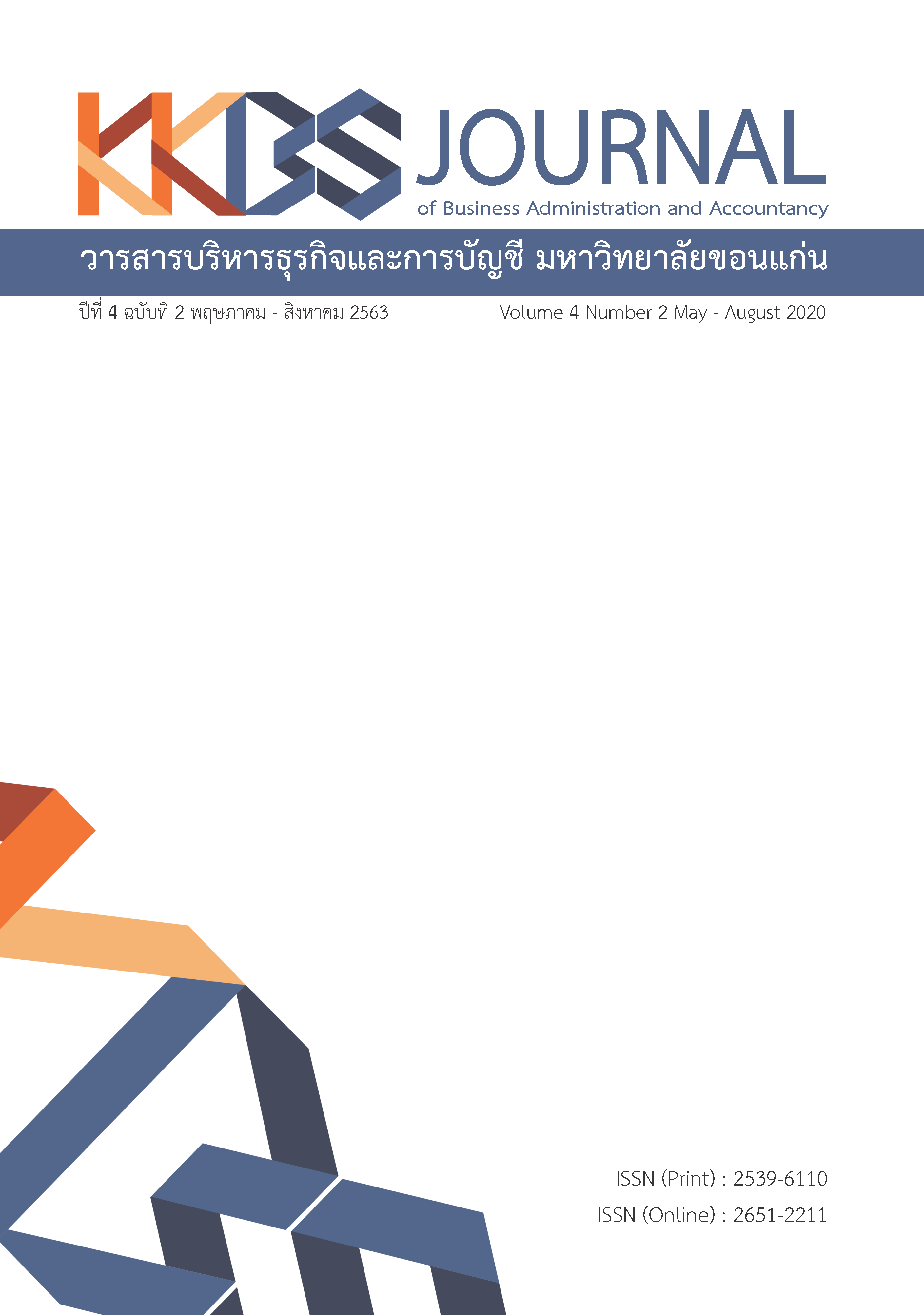Strategic Pricing and Firm Performance: Evidence from Cosmetics SMEs in Thailand
Main Article Content
Abstract
This study aims at examining the effects of strategic pricing on firm performance. The samples of the study are 148 cosmetics SMEs in Thailand. The results find that strategic pricing has a positive effect on market response, sustainable competitive advantage and firm performance. Also, market response has a positive influence on both sustainable competitive advantage and firm performance while sustainable competitive advantage has a positive impact on firm performance. This study confirms that strategic pricing is a dynamic capability and it is a key factor of their competitive advantage and performance.
Article Details
The articles published in the journals are the authors' opinions, not the opinion of the editorial team or administrative staff. The articles published is copyright of the Journal of Business Administration and Accounting, Khon Kaen University.
References
Aaker, D.A., Kumar, V. & Day, G.S. (2001). Marketing research. New York: John Wiley and Sons.
Ailawadi, K., Lekmann, D.R. & Neslin, S.A. (2001). Market response to a major policy change in the marketing mix: learning from Procter and Gamble’s value pricing strategy. Journal of Marketing, 65, 44-61.
Armstrong, J.S. & Overton, T.S. (1977). Estimating non-response bias in mail surveys. Journal of Marketing Research, 14(3), 396-402.
Bentler, P.M. (1990). Comparative fit indices in structural models. Psychological Bulletin, 107, 238-246.
Bollen, K.A. & Long, J.S. (1993). Testing structural equation models. California: Sage Pub.
Byrne, B.M. (1998). Structural equation modeling with LISREL, Prelis and Simplis: Basic concepts, applications and programming. New Jersey: L. Erlbaum Associates.
Cadez, S. & Guilding, C. (2008). An exploratory investigation of an integrated contingency model of strategic management accounting. Accounting, Organizations and Society, 33(7-8), 836-863.
Cannon, H.M. & Morgan, F.W. (1990). A strategic pricing framework. The Journal of Services Marketing, 4(2), 19-30.
Churchill, G.A., Jr. (1979). A paradigm for developing better measures of marketing constructs. Journal of Marketing Research, 16(February), 64-73.
Griffiths, G.H. & Finlay, P.N. (2004). IS-enabled sustainable competitive advantage in financial services, retailing and manufacturing. Journal of Strategic Information System, 13, 29-59.
Hair, J.F., Black, W.C., Babin, B.J. & Anderson, R.E. (2010). Multivariate data analysis: A global perspective. 7th ed. New Jersey: Person Prentice Hall.
Herda, D.N. & Lavelle, J.J. (2012). The auditor-audit firm relationship and its effect on burnout and turnover intention. Accounting Horizons, 26(4), 707-723.
Kazemi, S.M.R., Hadavandi, E., Mehmanpazir, F. & Nakhostin, M.M. (2013). A hybrid intelligent approach for modeling brand choice and constructing a market response simulator. Knowledge-Based Systems, 40, 101- 110.
Kim, K.H., Jeon, B.J., Jung, H.S., Lu, W. & Jones, J. (2012). Effective employment brand equity through sustainable competitive advantage, marketing strategy and corporate image. Journal of Business Research, 65, 1612-1617.
Kline, R.B. (1998). Principles and Practices of Structural Equation Modeling. New York: The Guilford Press.
Lubit, R. (2001). Tacit knowledge and knowledge management: the keys to sustainable competitive advantage. Organizational Dynamics, 29(4), 164-178.
Lumpkin, G.T., Droege, S.B. & Dess, G.G. (2002). E-commerce strategies: achieving sustainable competitive advantage and avoiding pitfalls. Organizational Dynamics, 30(4), 325-340.
Nunnally, J.C. & Bernstein, I.H. (1994). Psychometric theory. New York: McGraw-Hill.
Reed, R., Lemak, D.J. & Mero, N.P. (2000). Total quality management and sustainable competitive advantage. Journal of Quality Management, 5, 5-26.
Simmonds, K. (1981). Strategic management accounting. Management Accounting, 59(4), 26-30.
Teece, D.J., Pisano, G. & Shuen, A. (1997). Dynamic capabilities and strategic management. Strategic Management Journal, 18(7), 509-533.
Turner, M.J., Way, S.A., Hodari, D. & Witteman, W. (2017). Hotel property performance: the role of strategic management accounting. International Journal of Hospitality Management, 63, 33-43.
Tzokas, N., Hart, S., Argouslidis, P. & Saren, M. (2000). Strategic pricing in export markets: empirical evidence from the UK. International Business Review, 9, 95-117.
Ward, K. (1993). Accounting for a sustainable competitive advantage. Management Accounting, 71, 36-38.


